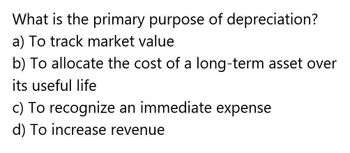
Cornerstones of Cost Management (Cornerstones Series)
4th Edition
ISBN: 9781305970663
Author: Don R. Hansen, Maryanne M. Mowen
Publisher: Cengage Learning
expand_more
expand_more
format_list_bulleted
Question
thumb_up100%
What is the primary purpose of

Transcribed Image Text:What is the primary purpose of depreciation?
a) To track market value
b) To allocate the cost of a long-term asset over
its useful life
c) To recognize an immediate expense
d) To increase revenue
Expert Solution
This question has been solved!
Explore an expertly crafted, step-by-step solution for a thorough understanding of key concepts.
Step by stepSolved in 2 steps

Knowledge Booster
Similar questions
- The amortization process is like what other process? A. depreciation B. valuation C. recognizing revenue D. capitalizationarrow_forwardWhich of the following statements about capitalizing costs is correct? A. Capitalizing costs refers to the process of converting assets to expenses. B. Only the purchase price of the asset is capitalized. C. Capitalizing a cost means to record it as an asset. D. Capitalizing costs results in an immediate decrease in net income.arrow_forwardWhich of the following accounts would not be included in the Acquisition and Payment for Long-Lived Assets Cycle? a. Revenue b. Depreciation expense c. Gain on disposal d. Equipmentarrow_forward
- Depreciation of a plant asset is the process of ________. A. asset valuation for statement of financial position purposes B. allocation of the assets cost to the periods of use C. fund accumulation for the replacement of the asset D. asset valuation based on current replacement cost dataarrow_forwardProvide right Ansarrow_forwardWhat is the purpose of charging depreciation in financial statements? A To allocate the cost of a non-current asset over the accounting periods expected to benefit from its use B To ensure that funds are available for the eventual replacement of the asset C To reduce the cost of the asset in the statement of financial position to its estimated market value D To account for the ‘wearing-out’ of the asset over its lifearrow_forward
- what is the ultimate purpose of long-term assets? How should the cost of these assets be allocated over the asset's useful life? Why is depreciation not synonymous with valuation?arrow_forward3) Which of the following best describes a depreciation base?7) The acquisition cost of an asset relative to its fair value O The estimated market value of an asset at the end of its useful life O The historical cost of an asset less the depreciation recognized to date O The amount that should be expensed over an asset's useful lifearrow_forward4. The most appropriate definition of depreciation is: A. A means of determining the decrease in the market value of an asset over time B. A means of allocating the cost of an asset over a number of accounting periods C. A means of setting funds aside for the replacement of the asset D. A means of estimating the current value of the assetarrow_forward
- Which of the following best describes depreciation? A.ccounts for the market value of a physical asset B.Part of the cost of a physical asset allocated as an expense to each time period in which the asset is used. C.Shows the increase in value of a physical asset over the asset’s useful life D.Shows the drop in value of an asset when the asset is first used by an entityarrow_forwardWhy is depreciation expense recognized? Select one: a. To provide a better estimate of the market value of the depreciated assets. b. So that the balance sheet value of plant assets will more accurately reflect the replacement cost of the assets. c. To ensure that cash will be available at the end of the assets' useful life in order to replace it. d. To match the cost of the asset against the revenue using a reasonable allocation. method. Save AnswersNextarrow_forwardDepreciation is a process that involves:a. Increasing the value of assetsb. Distributing the cost of an asset over its useful lifec. Eliminating the need for financial statementsd. Reducing the value of liabilitiesarrow_forward
arrow_back_ios
SEE MORE QUESTIONS
arrow_forward_ios
Recommended textbooks for you
 Cornerstones of Cost Management (Cornerstones Ser...AccountingISBN:9781305970663Author:Don R. Hansen, Maryanne M. MowenPublisher:Cengage LearningPrinciples of Accounting Volume 1AccountingISBN:9781947172685Author:OpenStaxPublisher:OpenStax College
Cornerstones of Cost Management (Cornerstones Ser...AccountingISBN:9781305970663Author:Don R. Hansen, Maryanne M. MowenPublisher:Cengage LearningPrinciples of Accounting Volume 1AccountingISBN:9781947172685Author:OpenStaxPublisher:OpenStax College Intermediate Financial Management (MindTap Course...FinanceISBN:9781337395083Author:Eugene F. Brigham, Phillip R. DavesPublisher:Cengage Learning
Intermediate Financial Management (MindTap Course...FinanceISBN:9781337395083Author:Eugene F. Brigham, Phillip R. DavesPublisher:Cengage Learning Intermediate Accounting: Reporting And AnalysisAccountingISBN:9781337788281Author:James M. Wahlen, Jefferson P. Jones, Donald PagachPublisher:Cengage Learning
Intermediate Accounting: Reporting And AnalysisAccountingISBN:9781337788281Author:James M. Wahlen, Jefferson P. Jones, Donald PagachPublisher:Cengage Learning

Cornerstones of Cost Management (Cornerstones Ser...
Accounting
ISBN:9781305970663
Author:Don R. Hansen, Maryanne M. Mowen
Publisher:Cengage Learning

Principles of Accounting Volume 1
Accounting
ISBN:9781947172685
Author:OpenStax
Publisher:OpenStax College


Intermediate Financial Management (MindTap Course...
Finance
ISBN:9781337395083
Author:Eugene F. Brigham, Phillip R. Daves
Publisher:Cengage Learning


Intermediate Accounting: Reporting And Analysis
Accounting
ISBN:9781337788281
Author:James M. Wahlen, Jefferson P. Jones, Donald Pagach
Publisher:Cengage Learning